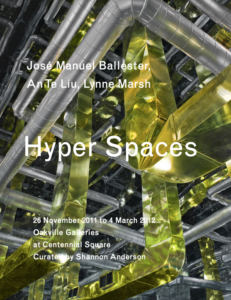Essay
Hyper Spaces:
José Manuel Ballester, An Te Liu, Lynne Marsh
By: Shannon Anderson

If we are to believe the theories of philosophers such as Paul Virilio, we have already entered the future. A fundamental shift in how we understand the “real world” has occurred in that the idea of the virtual is all encompassing. According to Virilio, we now live in two realities, one actual and one virtual. On the one hand, we have always held the “real” at a certain distance through the mediation of our thoughts and dreams, a distance acknowledged as early as the seventeenth century by René Descartes.2 On the other hand, we can point to the prevalence of the screen in our daily lives, beginning with film and television, then to the computer screen’s increasing presence in our space of communication, especially as it becomes more mobile in the form of GPS readers, BlackBerry devices, and iPads. It should come as no surprise that our persistent need to shift between these two worlds — the virtual and the real — might provoke a third space, a space which lies in both of these worlds, and neither of them. We might call it hyperreality or hyperspace, an alternative realm normally attributed to science fiction, but that seems ever closer to the present moment. (Excerpt)
Referenced Work
2008